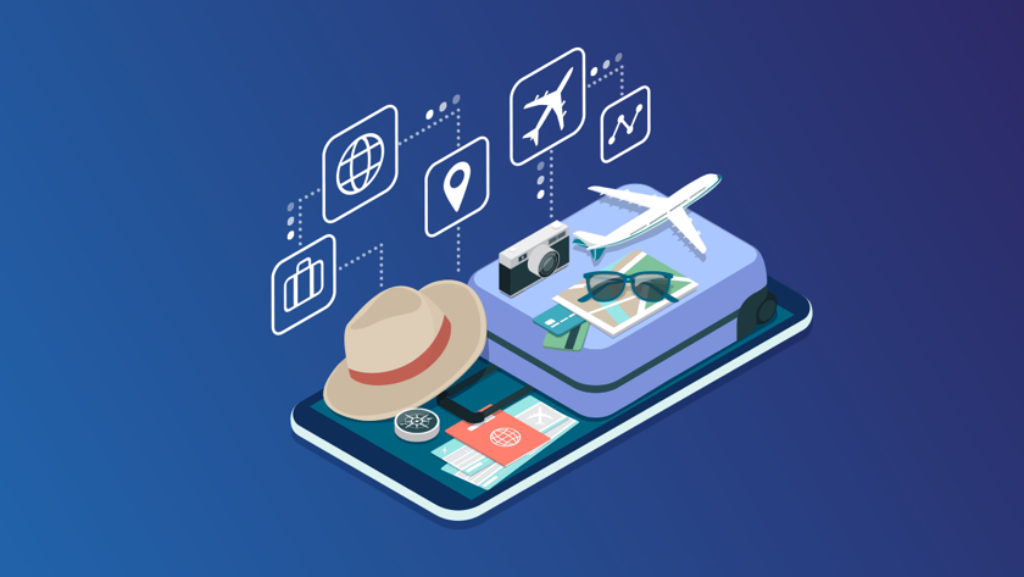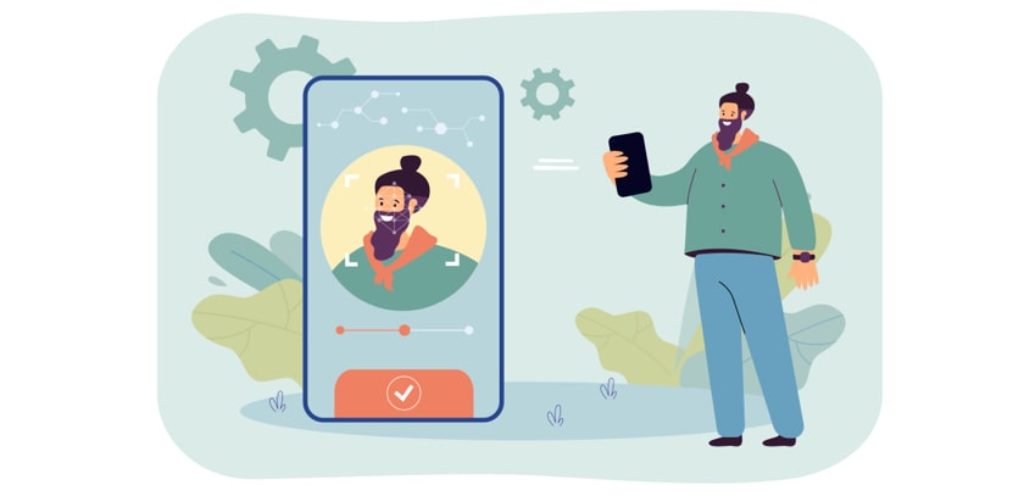Table of Contents
Technology has greatly changed the way we do business and the travel and hospitality industry is no exception. A host of tech solutions, from online booking platforms to virtual hotel tours, have made our traveling experience far more enjoyable. And as the industry keeps implementing new solutions, travel and hospitality companies need to keep up with these changes in order to maintain a leadership position. To do so, they may need to rethink their current business decisions and make them more tech-centric.
Without further ado, let’s dive into the cutting-edge technologies that are changing the face of the modern travel industry, and see the main benefits that they have to offer.

What is travel technology?
Travel tech is the use of technology in the hospitality and tourism industry with an aim to automate and facilitate processes and make the customer experience more enjoyable and user-centric. Examples of travel technology are flight tracking, instant access to content from anywhere, online booking, and much more.
Travel tech is not a new trend – we can call it an evolving one. The travel and hospitality industry has been using technology for quite a while but only in recent years has it put emphasis on implementing high-tech solutions. The rise of IoT and AI, robotic process automation (RPA) and the growing popularity of chatbots – all these innovations have added an exciting competitive edge to the existing processes.
The impact of the pandemic on the travel industry
One more factor that contributed to the transformation of the travel industry is the Covid-19 pandemic. According to the World Tourism Organization, the number of international arrivals in January 2022 was 67% below the pre-pandemic level. In addition, the experts from the WTO believe that the industry will not fully recover until 2024.
Due to the need to adapt to the new conditions, hotels and tour operators are taking all kinds of measures to restore the industry. One of the ways to do so is by implementing technology to free people from certain routine operations (robots and chatbots) and to reduce risks associated with the spread of the virus (biometric recognition and QR scanning). Since the main point of focus is safety, technology plays a major role in creating safe conditions for both travelers and employees.
The undeniable benefits of travel technology
Due to continuous technological advancement and the arrival of the pandemic, tourists’ expectations have shifted towards safety and affordability. These demands bring changes to the travel industry and companies need to adjust to them. This is where travel technology steps in and helps companies not only meet customer expectations but exceed them:
- Security: contactless technology creates a highly controlled environment, thus improving the safety of travelers and employees.
- Flexibility: tasks that used to take time (i.e.booking a room or obtaining information about a destination), are now handier due to accessibility and automation.
- Reduced staffing costs: chatbots and robots as well as the Internet of Things helps reduce staffing costs and improve customer service.
- Enhanced customer experience: through automation and personalization, technology can instantly and accurately fulfill customer requests and simplify the travel process.
Below, we’ll focus on the major tech trends in tourism that businesses should keep a close eye on for a smart investment. Here are our top picks.
Voice search
According to Google, 27% of Internet users worldwide use voice search on their mobile devices. Given the convenience of voice search in terms of speed and accessibility, it is not surprising that this technology is gaining momentum in the travel industry.
Voice control helps improve customer service in hotels by allowing guests to control the room’s temperature or light, order a meal, make a restaurant reservation or check the weather forecast at any time, all through voice search.
A great real-life example is Expedia Skill for Amazon Alexa, which was designed specifically for trip management. This skill helps you make traveling decisions by answering questions about transportation costs, destinations that fit your budget and interests, flight statuses, and car reservations.
Autonomous Robots
Another example of travel technology is autonomous robots. There are many uses for robots in the travel and hospitality industry: robot butlers in hotels or Knightscope robots in airports that are capable of detecting prohibited items. In general, the use of robots helps reduce human contact and improves service and safety, which is especially important in the era of the pandemic.
One real-life example of using robots in tourism is the Henn-na Hotel in Japan, recognized as the world’s first hotel with a fully robotic staff. In this hotel, robots work at the front desk, at customer information points, and in storage and they use voice and facial recognition and artificial intelligence technologies to provide a range of services to hotel guests.

Another great example is Travelmate – a robotic suitcase that takes the hassle out of travel. The suitcase can autonomously follow its owner by using collision detection technology and thus eliminates the need to carry the suitcase in hand.
Virtual reality (VR) and augmented reality (AR)
What if you could offer a potential customer a virtual tour of your hotel, resort, or destination where your business operates? Today this is available thanks to virtual and augmented reality technologies.
Virtual reality allows you to be virtually transported to any location and hotels like Marriott, Best Western, and Holiday Inn, have already taken advantage of it and now provide virtual tours to their guests. Augmented reality, in turn, enhances the traveling experience by providing details about local destinations that can be displayed on mobile devices when a tourist points their device at it. In this way, AR provides valuable information about a certain destination at the exact time when it is most relevant.
In general, AR and VR enhance the travel experience, help make the final decision at the booking stage and help overcome the language barrier. In addition, it is one of the great ways to gain a competitive edge! AI Chatbots
According to IBM, chatbots can save companies up to 30% in their customer support costs which sounds pretty great. So how can you use chatbots in the travel industry?
A smart AI-powered chatbot can bring the following benefits:
- Improve the booking experience;
- Provide support throughout the whole journey;
- Provide an extra level of personalization;
- Offer multi-lingual functionality.

In general, chatbots can provide assistance to tourists at every step of their journey, offer them tailored recommendations based on their preferences, and basically be their personal travel assistants. A great example of this is an FCM Travel Solutions (Sam) chatbot, based on artificial intelligence. The chatbot has real-time chat integration, an unobtrusive manner of communication, and a customizable reminder system. The chatbot alerts customers about the upcoming travel dates or the need to leave for the airport in advance, as well as provides valuable weather alerts. All in all, it sounds like a perfect traveler’s friend!
Contactless solutions (QR scanning)
The COVID-19 pandemic caused the all-around implementation of contactless solutions to keep employees and guests safe and minimize human contact. For instance, many restaurants and tourist destinations now require visitors to scan the QR code on their PCR tests in order to enter. As well, airlines such as Finnair, Delta, and British Airways have already implemented digital payment solutions to appease the contemporary traveler and they now provide a simpler QR scanning payment process.
In the light of the pandemic, AirAsia quickly introduced several contactless procedures such as a passenger reconciliation system (PRS) and contactless payments in airports. Another example of a contactless solution is IFE Zero-Touch by Qatar Airways. It is an in-flight entertainment technology that allows passengers to connect their personal electronic devices (PEDs) to IFE screens on the back of their seats. Passengers can either connect to the Wi-Fi or scan a QR code to use their PEDs to navigate and control the system from their mobile devices.
Biometric recognition
Biometric recognition is transforming with an amazing speed and now includes recognition by finger or facial prints, by an iris, by a palm print, by a retina, or even by one’s gait. And since biometric recognition provides a high level of security in terms of user authentication, no wonder this technology has made its way into tourism and hospitality.
An example of a successful implementation of facial recognition technology is the Marriott hotel in China. Visitors must scan their IDs, take a photo and enter their contact information into a specialized device. The device will then issue their room key cards after successfully verifying their identity and reservation information.

Big data and predictive analysis
Data is the fuel for the modern tourism and hospitality industry. Hotels and tour operators can use Big Data to gain valuable information about customers, predict their possible behavior, and provide them with relevant offers. As well, Big Data contributes to better revenue management since it allows to build forecasts based on past demand, past customer behavior, and various external factors.
For example, hotels can use predictive analytics to enhance their dynamic pricing strategy. Dynamic pricing means a hotel can change its rates based on a number of factors, such as the current level of demand, external events (i.e. a big festival happening nearby), and others. By implementing predictive analytics, hotels can make their dynamic pricing strategy much more accurate and provide better offers to their guests.
Another way how Big Data benefits tourism and hospitality is enhanced personalization. By studying customers’ behavior and habits in detail, companies can adjust their marketing strategy and make more personalized and relevant offers which, in turn, will lead to increased customer satisfaction and improved loyalty towards a company.
Final thoughts
The tourism and hospitality industry is all about customer service so you need to make sure that you are providing your clients with an excellent one. And the use of travel technology can help you not only stay on top of the game but make sure your business will keep growing in the long run.


Comments